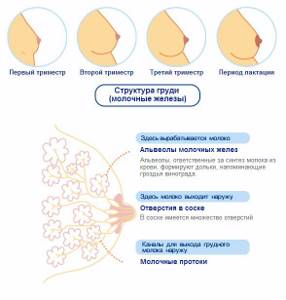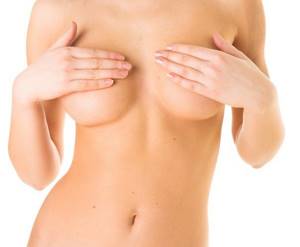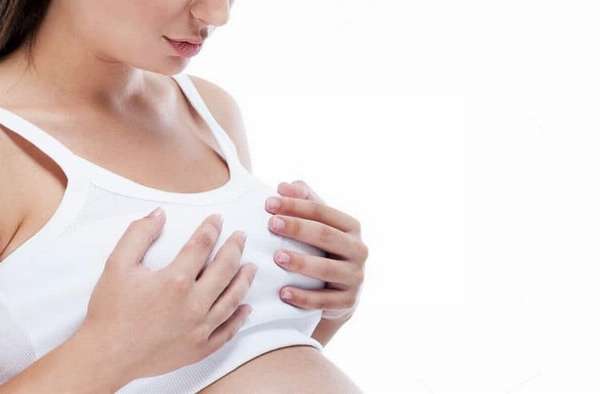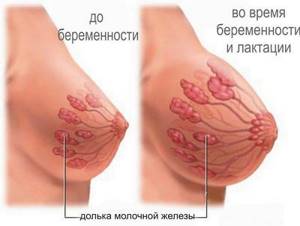What happens to the breasts during pregnancy?
Throughout the 9 months of pregnancy, the woman's breasts begin to gradually prepare for the upcoming breastfeeding of the child. Changes in the breast occur such as:
- the volume increases, in some cases up to several sizes (most often this phenomenon occurs during the first 10 weeks of pregnancy, as well as immediately before childbirth);
- The breasts become sensitive and increased pain may occur. Expectant mothers begin to feel tingling or numbness in the chest;
- The nipples and areola also increase in size. Small tubercles appear around the nipple, which are called “Montgomery tubercles”;
- over time, the woman notices the appearance of colostrum, which is a thick yellow discharge (most often such changes occur in the fourth month of pregnancy);
- The nipples and the skin around them gradually darken, and a venous network may appear (as a result of increased blood flow in the mammary gland, darkening of the blood vessels occurs).
Reasons for changes
Hormonal changes are to blame for what happens to the breasts during pregnancy. Active production of estrogen and progesterone begins immediately after conception. It is these hormones that regulate the preservation and successful gestation of the fetus. The presence of human chorionic gonadotropin in the blood also characterizes the onset of pregnancy; it is its content that is detected by modern tests.
Prolactin is produced in connection with the formation of the placenta; it is involved in all processes associated with changes in the mammary glands.
How to care for your breasts during pregnancy?
Having learned about her interesting situation, first of all, the girl needs to take care of choosing the right bra. It is important to choose a model that will not put pressure on the breasts, but at the same time perfectly supports the breasts. It is advisable to choose models with fairly wide straps, without wires and an adjustable clasp.
The most important thing during this period is to wear only high-quality underwear, specially designed for pregnant women. If you can’t choose underwear on your own, you should consult a doctor who will monitor the course of your pregnancy.
To prevent drops of colostrum from getting on your laundry, you should use special tabs that will prevent drops from leaking onto your clothes. It is also recommended to use such inserts during breastfeeding.
Special hardening of the breasts using a contrast shower, which should be done regularly, also brings benefits. You can also do soft rubbing with a washcloth - gentle circular movements are made around the areola to the base of the breast, but the nipples themselves should not be touched.
To strengthen the skin of the nipples, as well as prevent the appearance of painful cracks on their surface during breastfeeding, it is recommended to use a contrast shower. You should not listen to the advice of your girlfriends and use various methods of irritating your nipples (for example, massaging your nipples with a thick terry towel, etc.). It is important to remember that any type of nipple stimulation can cause the uterine muscles to contract.
During pregnancy, many expectant mothers face the problem of stretch marks on their breasts, which occurs as a result of an increase in their size. To avoid such trouble, it is recommended to perform a light massage using almond oil. This procedure should be done immediately after taking a bath or shower. For this purpose, you can also use special creams prescribed to combat stretch marks, but before using them, you must consult your doctor.
If changes occur in the breasts that cause an unpleasant feeling of discomfort and anxiety in a woman, she should seek help from a doctor as soon as possible.
Fighting stretch marks
Many women know what stretch marks look like during pregnancy, but what can you do to prevent their appearance?
In many ways, the appearance of stretch marks depends on diet, so to prevent a woman from developing stretch marks on her breasts during pregnancy, she should take care of this in advance. Before conception and during pregnancy, you need to consume foods rich in vitamins A and E, and you should also give up bad habits: smoking and drinking alcohol.
There are cosmetics that are used for skin care, no matter at what stage of pregnancy breasts begin to grow, but when purchasing, you should make sure whether they can be used by pregnant or lactating women. For this purpose, special markings have been developed and applied to the packaging.
Modern aesthetic medicine offers many ways to correct this external defect, but it is not recommended to resort to them immediately after childbirth, since the woman’s body has not yet recovered during this period.
Timely, high-quality care for the mammary glands will relieve many health problems; you should not neglect the consultation of an experienced specialist!
If your breasts stop hurting during pregnancy
Breast pain during pregnancy is very similar to symptoms of menstruation. Even with minimal hormonal levels, certain changes begin to occur. At the very beginning of pregnancy, almost imperceptible pain may bother you, but over time it can intensify or subside completely.
Many girls notice that their breasts become very sensitive, as a result of which even the slightest touch can cause a strong feeling of discomfort. Similar sensations can accompany the expectant mother throughout almost the entire pregnancy. But at the same time, such changes occur on a purely individual basis and for some they may appear throughout pregnancy, while for others they disappear a month after conception.
At the same time, there are cases that during pregnancy the breasts not only do not increase in size, but also hurt, and sometimes decrease. It is worth remembering that this is not a sign of serious worries and worries, because the female body can react differently to conceiving a child.
Of course, the beginning of an increase in breast size is one of the main signs of pregnancy, but if this does not happen, this is explained by the characteristics of the body. If this causes a strong feeling of anxiety, then you should consult your gynecologist. It is important to remember that not only physical health is important during pregnancy, but also a lack of stress and a good mood.
The doctor will conduct an examination and will be able to determine whether the pregnancy is normal or if there are any abnormalities. Most often, expectant mothers worry in vain and the pregnancy proceeds without pathologies.
In almost all cases, breast tenderness during pregnancy is a concern until about the 12th week of pregnancy. If over time the breasts decrease in size and there is no feeling of pain, there is a possibility that these signs will appear during the last months of pregnancy.
Video
You will learn how to properly care for the mammary glands during pregnancy from our video.
The mammary glands are a sensitive organ, especially if hormonal changes occur in the body. This process is especially relevant when a woman is in an interesting position.
Most expectant mothers experience chest pain in the early stages of pregnancy, and they wonder: why is this happening? Today we will talk about this phenomenon and try to find the answer to this question.
The main and clear sign that fertilization has taken place is a delay in menstruation. Until this is observed, it is quite difficult for a woman to determine her position, especially if the conception is unplanned, because on the first day the test is unlikely to show two stripes; at least 7 days must pass. The female body is wisely and intelligently created, and if the expectant mother is especially attentive, she will be able to notice that her mammary glands have become sensitive and pain has appeared.
Changes begin to occur within a few days after fertilization, but quite often a woman does not pay special attention to this symptom, since this condition is observed in many women before menstruation.
It is impossible to name the exact time when breasts begin to hurt and grow, because each organism is individual, but we can say with confidence that this symptom is one of the first to appear in many people. As a rule, the pain goes away at the end of the 12th week and subsequently returns again before childbirth, shortly before the baby starts feeding. For some, unpleasant sensations may persist throughout pregnancy, but up to 12 weeks they are pronounced, and after that they do not bring discomfort to the mother.
It is also believed that in first-time mothers, pain and swelling are observed later than in women who have already had a pregnancy. They feel these changes earlier.
What changes occur in the breasts during pregnancy?
Already from the first days of pregnancy, certain changes occur in the female body - the body gradually prepares for the upcoming birth and breastfeeding of the child. Consequently, the mammary glands will also undergo changes.
The structure of the mammary glands consists of 15 or 20 lobes, which are divided into lobules and have milk ducts. As a result of the influence of certain hormonal changes in the breast, the volume of the ducts and lobules begins to increase, and the cells responsible for milk production begin to grow.
In some cases, with these changes, the weight of each mammary gland can reach 600-700 grams. Consequently, as a result, this leads to an increase in breast volume during pregnancy.
Most often, most breast enlargement occurs during the first 10-12 weeks, and of course, in the last weeks of pregnancy. During the 9 months of pregnancy, breasts can increase by a couple of sizes.

There is not only an increase in breast size, but also in its sensitivity. It is the ongoing changes that can lead to increased breast sensitivity, while a feeling of discomfort may appear even at the slightest touch, in some cases even severe pain appears.
Many women experience unpleasant painful sensations during pregnancy, which is normal. If after 12 weeks the discomfort does not go away on its own, it may become less noticeable. But at the same time, it is worth considering the fact that not all pregnant women are such women, and some expectant mothers experience a rather strong feeling of discomfort throughout pregnancy.
Breast changes such as increased sensitivity, tenderness and swelling of the breasts are among the very first signs of pregnancy. However, these are not all the changes that occur in the female breast during pregnancy.
Also, during pregnancy, the appearance of a venous network may occur, which in turn is caused by an increase in blood flow. The occurring hormonal changes lead to the fact that the nipple areolas not only increase in size, but also darken. The nipples themselves swell and begin to protrude.

Also, it is during pregnancy that the process of formation of colostrum occurs, which is a precursor to the appearance of milk. A special feature of colostrum is not only its characteristic yellow tint, but also the specific aroma of breast discharge. You should not worry if yellow fluid is released from your breasts during pregnancy, since the appearance of colostrum is normal and does not act as a sign of upcoming problems with breastfeeding. In some cases, colostrum can be released in quite large quantities during pregnancy, so it is recommended to regularly use special bra pads.
The changes listed above are normal and should not cause discomfort; however, they are common. All other changes can be caused by hormonal imbalances and there is a need to consult a doctor.
Helpful information
Very often during pregnancy, doctors may prescribe. You can learn more about the purpose for which such drugs are prescribed and how they are useful for the expectant mother and her child. Unfortunately, many women during this period are faced with such an ailment as a runny nose, so a very reasonable question arises: which ones can be used so as not to harm the baby? Also, sometimes mothers encounter diseases when they cannot do without.
It is also worth mentioning headaches, which can torment women during this period, so it is important to know which safe and effective ones exist. We invite you to understand these topics in more detail so that you are fully prepared.
At what stage or week of pregnancy did your breasts start to hurt? Or maybe you noticed other first signs of your interesting situation? Share your story, because this information may be useful for other women. We will also be glad to receive your feedback on this article in the comments.
A woman’s body is subject to changes during pregnancy, physiology dictates its own laws. They are also associated with hormonal changes, restructuring of the body for bearing a child, giving birth to a baby. The woman notices the rounded shape of the body, the figure takes on soft feminine contours. Along with the rest, the shape and size of the breast changes.
Such breast changes are mainly associated with preparation for the upcoming lactation period. Each woman has an individual period when breasts begin to grow during pregnancy. Changes in the glands begin after a woman manages to become pregnant. Immediately after the embryo is attached, the hormonal system and the body as a whole are reconfigured.
Hormones play a leading role in triggering and controlling changes in the body, including the mammary glands. Progesterone and estrogen have a direct effect on the gland and its ducts. Due to hypertrophy of the glandular tissue, breast swelling occurs and, accordingly, an increase in its size.
- The sensitivity of the mammary glands may increase, and even pain is possible.
- Breast size increases, sometimes it can grow several sizes.
- Stretch marks appear on the skin. The sign is strictly individual, associated with heredity and skin characteristics.
- The color of the areolar area and nipples changes, they darken and may increase slightly in size.
- A network of veins appears on the chest.
- At 6-7 months, colostrum begins to be released.
Remember that all of the listed signs are individual and not required. If nothing else bothers a pregnant woman, then there is no need to worry. Also, if there is bloody or brown discharge from the breast, consult a doctor immediately.
The most noticeable period when breasts swell during pregnancy is the first ten weeks and immediately before childbirth. At this time, the enlargement of the glands occurs most actively, because changes in the body occur at an intensive pace.
How can you better cope with changes in your breasts during pregnancy?
During pregnancy, quite a lot of different changes occur in the female breast, but the most unpleasant phenomenon is the increased pain and sensitivity of the breast, and, of course, an increase in its size.
To make pregnancy one of the happiest times in your life, you can use special bras that have an excellent supportive effect. It is advisable to opt for special underwear for pregnant women, which does not create strong pressure, but at the same time perfectly supports the breasts, and there are no bones that can cause an unpleasant feeling of discomfort.

The most important thing is that the bra exactly matches the size of the breast, and it should fit snugly enough to it, but not squeeze it. Therefore, during pregnancy you may need to purchase several bras that will come in different sizes.
Not only properly selected underwear can help reduce discomfort in the chest during pregnancy, but also simple physical exercises that help to perfectly strengthen the ligaments and muscles that are responsible for supporting the mammary glands, while significantly increasing the process of lymph drainage from the breast.
The most important thing during pregnancy is not to forget about the importance of hygiene procedures that must be carried out every day - the breasts are washed with warm water, using soft circular movements, and simple wiping with a damp towel also benefits.
Most often, during the release of colostrum there is no unpleasant feeling of discomfort. In some cases, too much colostrum may be released. Of course, you won’t be able to get rid of this phenomenon, but with the help of special tabs you can avoid the appearance of discharge on clothes.
When do changes begin and how long do they last?
Expectant mothers are often concerned with the question: how long do breasts hurt during pregnancy? The duration and intensity of breast transformations are very individual and depend on the personal characteristics of each woman’s body. For some, all the changes go away in a short period, and until the approach of childbirth, the bust ceases to bother them. Others experience swelling, sensitivity, itching and other sensations in the mammary glands for many months. In all cases, the changes are absolutely within normal limits.
For the most part, all necessary breast preparation takes place during the first trimester of pregnancy. And after the 10-14th week, all symptoms subside, and the bust completely adapts to hormonal changes.
It is very important to listen to your body and if you have any doubts, contact your doctor, since there is a lot of information now, and the concept of normal is very vague. Trusting unverified sources of information can only bring additional worries and worries, which is definitely not good for the expectant mother.

Breasts after pregnancy
Many women worry that after childbirth their breasts will lose their attractive shape. Of course, during pregnancy, the mammary glands swell and become more attractive, but after the birth of the baby, everything can change radically.

As soon as a woman stops breastfeeding her baby, a gradual return to the original state of the mammary gland lobes begins. As a result of the increase in breast weight during pregnancy, a gradual weakening of the ligaments and muscles that support it begins.
Because of this, you can see that after the end of lactation, the breasts deflate like a punctured balloon, and therefore gradually sag. The development of this unpleasant phenomenon can be avoided if timely measures are taken during pregnancy. It is important to regularly take care of your breasts, not only during pregnancy, but also during breastfeeding.
To ensure that your breasts retain an attractive shape and remain firm after pregnancy, it is recommended to regularly perform simple exercises based on muscle strengthening. It is advisable to start doing such exercises even before pregnancy. The fact is that taking into account how strong and strong the ligaments and muscles are, the level of breast support and maintaining an attractive shape after childbirth will depend.










